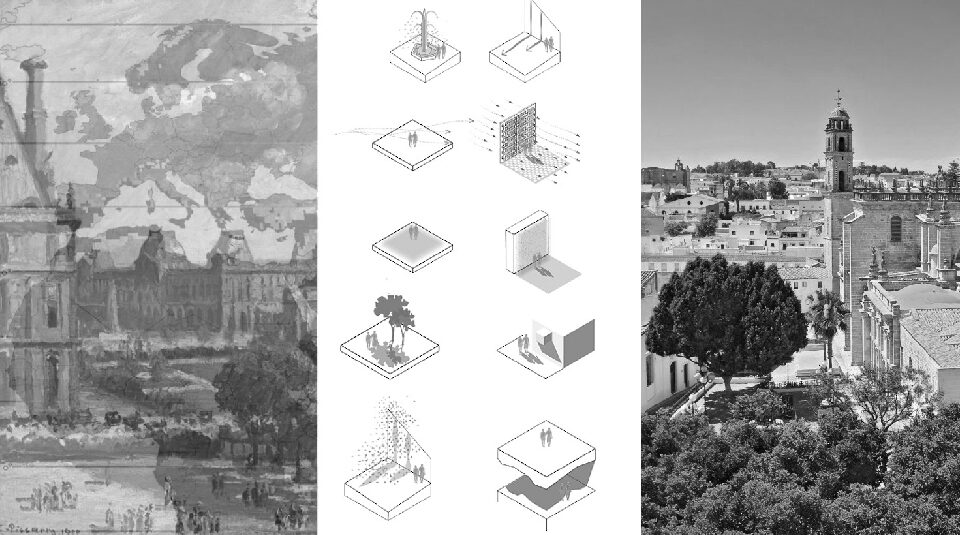The South on the horizon
Narrative

Intelligent Adaptation to the Environment
We all inherit a south and we ourselves are someone's south. If we want to sense tomorrow, to see what is coming, we have to “move” towards the South. It is a fairly simple journey but one that makes all the difference, since in doing so we learn a different way of conceiving. Thick walls, possibly through walls, patios to cool a public space, the use of plants, the presence of water... We have the south as our horizon, let's learn from the south. In the Mediterranean basin, there is a form of proto-ecology, an ability to adapt intelligently to one's environment that should inspire us.
In recent decades, a certain quantitative and abstract approach to the environment has been developed, which has made it possible to gather essential data and undeniable knowledge. The environment as an abstraction is based on the use of mathematical models, scenarios and indicators. Today, there is undoubtedly a need to reconcile the abstract aspect of the environment with its concrete reality.
For example, when creating the athletes' village for the Olympic Games in Saint-Ouen, it is not enough to design it as if it were located in Saint-Ouen. It is necessary to think about how it would be designed, for example, in Marseille.
We need to think about how to adapt intelligently to our environment, i.e. how to integrate harmoniously into something that is not a site or a plot of land, but an environment. So let's ask ourselves the necessary questions for the buildings: do we put ourselves in the shade? Do we put ourselves downwind? Are we white? Are we black? Do we contract or expand? Do we become overgrown? Are we capable of creating self-protecting urban forms that create their own shade?
Forward-Looking Approach
Adaptation undeniably brings significant changes. Until now, urban actors were mainly called upon to provide a realistic view of past and present data, as good forecasters. In other words, they had to present known information objectively. Today, we must become good futurologists by anticipating as best we can the unknown data of tomorrow, which is in fact knowable. Reports and scientists make predictions with a margin of uncertainty that depends on our collective efforts. In short, it is a question of presenting or anticipating future conditions, which leads us to adopt a prospective approach. This forces us to work in a slightly different way.
It is essential to open up the project teams by involving scientists, but also experts in scriptwriting and fiction, such as authors or directors. We should also have permanent access to current weather files, which is unfortunately not the case. The weather files embedded in dynamic thermal simulation software, for example, are often obsolete, based on weather statistics dating back ten, fifteen or even twenty years. This is extremely problematic. Moreover, these weather files come from generally isolated locations that are not densely built up and therefore do not take into account the phenomenon of UHIs (urban heat islands). This imprecision of the data is extremely detrimental to the accuracy of our interventions.
When we worked in the workshop on the climate strategy of a complex building such as the nave of the Grand Palais, we carried out delicate measurements in order to calibrate the dynamic thermal simulation models as closely as possible to reality. It was crucial to understand the internal meteorology of the structure. To do this, we installed sensors inside the nave to analyze the differentiation phenomena near the uninsulated walls and thus calibrate our models. We recorded the indoor and outdoor temperatures, revealing differences of 5 to 6 degrees between the actual temperatures and those provided by the weather files. These findings highlight the use of obsolete data in building design, thus emphasizing the need to adopt forward-looking data.
Adopting a forward-looking approach means constantly asking ourselves how we should design for tomorrow, to adapt to the climate of tomorrow. But how can we foresee tomorrow? How can we set ourselves this new horizon necessary for the design of suitable, comfortable and desirable cities and buildings?
In France and in the Northern Hemisphere, we must have the South as our horizon. With climate change in progress, southern climates are migrating north: in 2050, the climate of Paris will be that of Seville and in 2100, that of Tangiers. To act today, in new construction as well as renovation, we must use data from southern cities and draw inspiration from their best practices.
Climate, history, culture
Looking at the South as a horizon also means making the link between the climate, which is shaped by statistics and quantitative data, and history and culture. To learn about systems that create shade and venturi effects, use water and plants, etc.; but also to observe how the inhabitants of southern territories live with their climate - because you don't eat, socialize, work or dress the same way in Seville as you do in Helsinki. Let's see what is being done in the climates that will be ours tomorrow to build the city in line with the conditions of 2050, 2100 and beyond. Rather than fearing the Great Replacement, let's work instead on a beneficial form of cultural hybridization and make this link between climate, history and culture to design for tomorrow.